I know how debilitating a back injury can be. I am waiting to schedule my second surgery in five years. Take care my friend. Loren
You are using an out of date browser. It may not display this or other websites correctly.
You should upgrade or use an alternative browser.
You should upgrade or use an alternative browser.
Thumper--a 1 3/8" bore i.c. engine
- Thread starter Brian Rupnow
- Start date

Help Support Home Model Engine Machinist Forum:
This site may earn a commission from merchant affiliate
links, including eBay, Amazon, and others.
I built a little tractor using a Suzuki 3 cylinder 2 stroke engine, it was useless without a governor, as soon as the mower hit a tuft of grass it would die, with a governor it will mow grass at 10 kilometers per hour. Forty inch cut.Brian . That's the point I'm trying to make , your throttle should be connected to a governor. Set your RPM to 2000 ( no load ) as you load up the engine with the wood going through the saw , the RPM will drop , the governor will open the throttle to maintain the 2000 RPM . When the cut is finished and the RPM starts to increase the governor will start to close the throttle and maintain your 2000 RPM .
All small engines work this way except some outboard motors , they don't vary ignition timing like a car .
Bill
Loren---I am too. I have a couple of more tricks up my sleeve. This isn't dead yet. I'm just leaving things until my back feels a bit better.---Brian
Hello Brian, If I can make a couple of suggestions firstly the reason it won't idle slower is most likely it is too advanced at that speed to run as a test retard it to say 10 degrees and check its idle and maybe the mixture too may be a bit lean. Secondly if you open the throttle as the load comes on and keep the revs at 2000 it should handle your sawing operation. As It is I would assume it is loosing power because as the revs drop with the sawing opperation the 15 degree advance is too much and is working against developing power.So---What was the outcome of this exercise? Not what I would have liked, but I will explain. "Thumper", with it's larger bore is a lot more powerful than any of the other 1" bore engines that I tried to run the sawmill edger with. I can easily start the engine with the disengaged clutch driven by three rubber o-rings. With no o-rings in place, the engine idles at around 1000 rpm. With the load of the o-rings driving the clutch (while it is disengaged), the idle rpm's drop to about 800 rpm. However, the edger is designed to have an input of 2000 rpm driving the 16:1 gear reducer. This should turn the saw-blades at 1000 rpm, and turn the infeed rolls at a lower rpm so as not to over-run the saw-blades. I adjusted the engine to run at +/- 2000 rpm, and engaged the clutch. The engine took it all in stride, and didn't stall. There was a noticeable drop in engine rpm, but it drove the edger mechanism without any noticeable bogging. However, when I went to feed a board through the edger, the board would get about half way thru the saws, and then stall the engine. I repeated this about 10 times with different settings and adjustments, but it became plain that the new engine simply didn't have enough power. I have a theory, but at this time it is only a theory. With the ignition set to fire at 15 degrees before top dead center, the engine starts and idles very smooth, and revs up very well in response to opening the throttle. I have the feeling that at 2000 rpm, the timing is too slow for that rpm. The engine doesn't have any mechanism to advance the spark timing with changes in engine rpm. I believe that if I were to modify the engine so that as the throttle opened the ignition timing would advance automatically, the engine would be much more powerful at the 2000 rpm it is being asked for. I have decided to back away from this project for a while and do something else. I will probably come back to this and redesign the engine to give it an automatic spark advance, but for now I'm burned out on it.
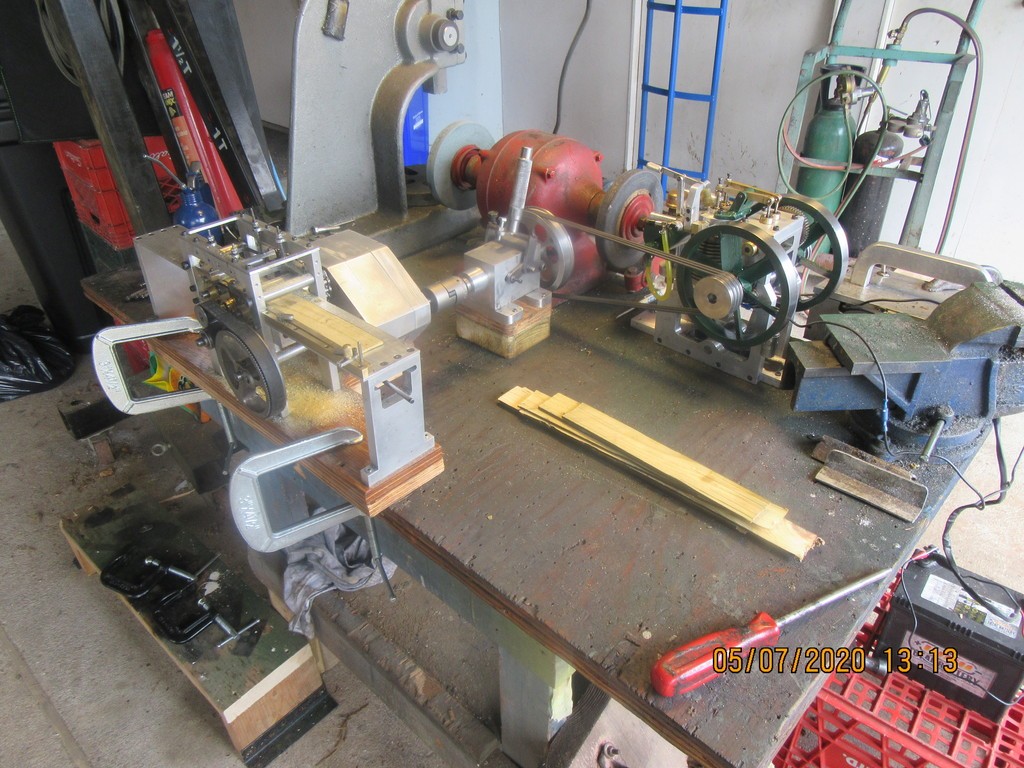
Hope this helps
John From down under.
Brian
In no way was I suggesting that you run your engine unrestrained and have six or eight weeks of work go flying onto the cement floor and smash to pieces. I was merely asking your thoughts on this engines balance while running. I did ask if you had run it unrestrained but in no way was I suggesting it.
Willy
In no way was I suggesting that you run your engine unrestrained and have six or eight weeks of work go flying onto the cement floor and smash to pieces. I was merely asking your thoughts on this engines balance while running. I did ask if you had run it unrestrained but in no way was I suggesting it.
Willy
It's okay willy. I wasn't offended. Some of my engines would set on a table unrestrained and putt away all day without trying to move. Some of them would take right off and walk across the floor. I always bolt my engines down, because it's kind of a crap shoot---I never really know how well or how poorly an engine is balanced until I run them.---Brian

$99.99
AHS Outdoor Wood Boiler Yearly Maintenance Kit with Water Treatment - ProTech 300 & Test Kit
Alternative Heating & Supplies

$39.99
$49.99
Sunnytech Low Temperature Stirling Engine Motor Steam Heat Education Model Toy Kit For mechanical skills (LT001)
stirlingtechonline

$599.00
$699.00
FoxAlien Masuter Pro CNC Router Machine, Upgraded 3-Axis Engraving All-Metal Milling Machine for Wood Acrylic MDF Nylon Carving Cutting
FoxAlien Official
![DreamPlan Home Design and Landscaping Software Free for Windows [PC Download]](https://m.media-amazon.com/images/I/51kvZH2dVLL._SL500_.jpg)
$0.00
DreamPlan Home Design and Landscaping Software Free for Windows [PC Download]
Amazon.com Services LLC

$89.99
Outdoor Wood Boiler Water Treatment Rust Inhibitor- AmTech 300 & Test Kit
Alternative Heating & Supplies

$17.29
$18.99
Product-Led SEO: The Why Behind Building Your Organic Growth Strategy
The Quality Books

$37.38
$49.99
Becker CAD 12 3D - professional CAD software for 2D + 3D design and modelling - for 3 PCs - 100% compatible with AutoCAD
momox Shop
There are a few things that affect idle speed, the weight of the flywheel, (more is better), compression (less is better) valve timing and duration (must be a compromise with the speed requirements) I cut down a six cylinder Toyota motor to single, it would not run at all until I ground the cams away to allow a shorter duration, ignition timing the Suzuki 3 cylinder 2 stroke Jeep engine had no auto advance you had to set the dizzy up at the best spot. Ted from down under. Look after that back Brian, cheers.Hello Brian, If I can make a couple of suggestions firstly the reason it won't idle slower is most likely it is too advanced at that speed to run as a test retard it to say 10 degrees and check its idle and maybe the mixture too may be a bit lean. Secondly if you open the throttle as the load comes on and keep the revs at 2000 it should handle your sawing operation. As It is I would assume it is loosing power because as the revs drop with the sawing opperation the 15 degree advance is too much and is working against developing power.
Hope this helps
John From down under.
Brian, If you want proper rpm control over your motor under a varying load you need a throttle controlled governor. Yes, there are many engines with dynamic ignition systems but I have never seen one that used that as their only/main speed control. If you look at today's small production motors like Lawn Mowers, Garden Tractors, Snow Blowers and Generators they all have some type of speed sensing throttle controll. Early lawn mowers used cooling air pressure pushing on a spring loaded plate connected to the throttle. This was simple and also quit sensitive. Today they use a set of fly weights spinning inside the crankcase that is directly connected to the throttle and uses variable spring pressure to set the motors rpm's.
Willy
Willy
Since I want to run Thumper at a much greater speed than at idle, I need to be able to adjust the timing of the engine. With a non adjustable ignition timing, the engine will run much faster than at idle, but it really doesn't have a lot of power at higher rpm. The cheap and quick way to address this is to mount the ignition points on a separate timing plate which can be adjusted with an attached lever. A #10 shcs and spring washer go thru the slot into the frame of the engine so the adjustable timing plate will hold itself in whatever position you set the handle at. This current set up will give an adjustment range of a total 120 degrees. It is pivoted on the crankshaft. This set-up will allow me to advance the engine timing when it is running at a higher speed. I have hidden the near side flywheel here so that the ignition advance mechanism is visible. The ignition points are attached to the timing plate and rotate with it, thus advancing or retarding the ignition.
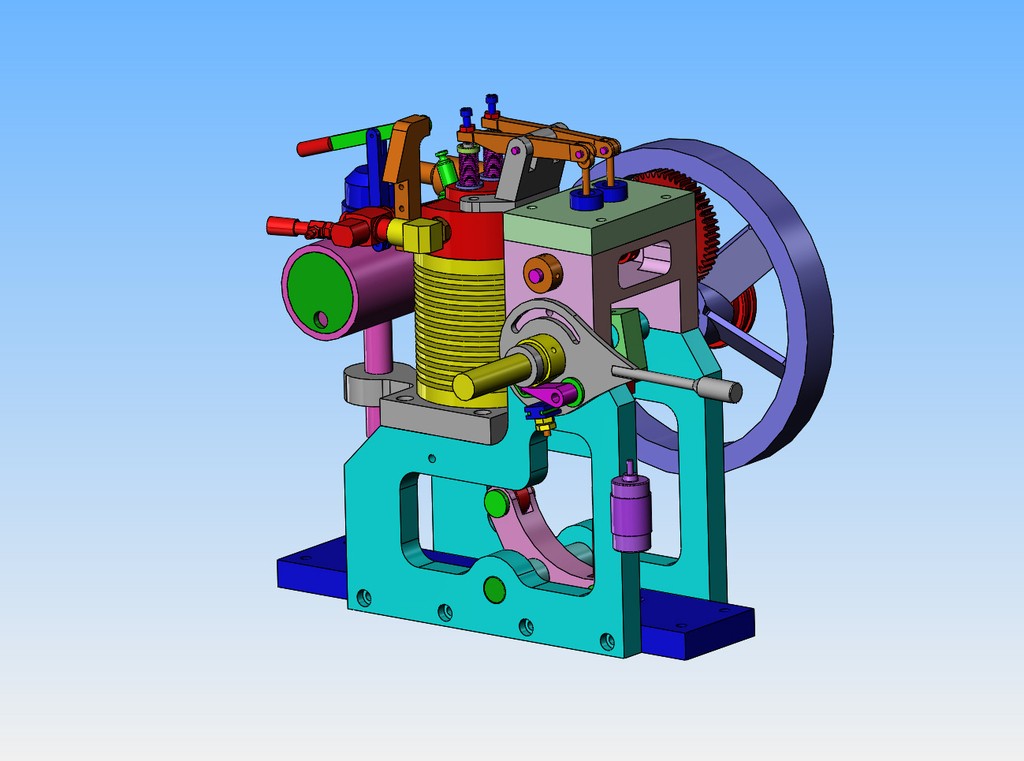

- Joined
- May 20, 2018
- Messages
- 200
- Reaction score
- 86
Hope this one works, Must apologize for the dog wanting to get in on the action.
Very cool video. Are there any drawings for the full size track runner?
- Joined
- May 20, 2018
- Messages
- 200
- Reaction score
- 86
Also, I am fluent in Dog. Sam just wants to know if he can borrow the motor trolley and go cruising for chick poodles. I don't blame him. That's a really amazing machine!Very cool video. Are there any drawings for the full size track runner?
Also, the high speeds your friend is running at, would that make him a Scofflaw? Or a Galoot?
- Joined
- May 20, 2018
- Messages
- 200
- Reaction score
- 86
You are an excellent engineer! The machine works great right off the bat!I have a number of requests for plan sets. Tomorrow I will open each drawing and save it as a pdf file so that no special software is needed to open and print the drawings. This will take a couple of hours, as there are 60 drawings and some of them are multiple sheets. I charge $25 Canadian funds, payable to Paypal. If you send money to [email protected] at Paypal, they will notify me and I will send you a zip file with all of the part and assembly drawings. Please specify that it is the drawing set for "Thumper".---Brian Rupnow
Do you have other engine plans that you sell? I will be sending you an order for a set of "Thumper" plans tomorrow! I really enjoyed this build and the accompanying log and photos!
Hi Brian, looks great but that won't give you enough power for your job without a governor, simplest way would be to fit an air vane behind the flywheel/fan connected to the throttle with a spring opening the throttle and the vane closing it. A mechanical governor is more reliable but the air one should allow a power increase as the load comes on. Can vary the speed by varying the spring tension. Ted from down underSince I want to run Thumper at a much greater speed than at idle, I need to be able to adjust the timing of the engine. With a non adjustable ignition timing, the engine will run much faster than at idle, but it really doesn't have a lot of power at higher rpm. The cheap and quick way to address this is to mount the ignition points on a separate timing plate which can be adjusted with an attached lever. A #10 shcs and spring washer go thru the slot into the frame of the engine so the adjustable timing plate will hold itself in whatever position you set the handle at. This current set up will give an adjustment range of a total 120 degrees. It is pivoted on the crankshaft. This set-up will allow me to advance the engine timing when it is running at a higher speed. I have hidden the near side flywheel here so that the ignition advance mechanism is visible. The ignition points are attached to the timing plate and rotate with it, thus advancing or retarding the ignition.

I scrounged around in my flat plate box to find a piece of material to make this manual spark advance from, and the only bit I found close to the right thickness had some rust pits on it. Oh well, that will be hidden in behind the flywheel. I have to call my nut and bolt store and see what they have in the line of Belleveille spring washers so that I can put them under the head of the bolt which goes thru the slot into the engine frame to keep the spark advance from slipping and resetting itself.
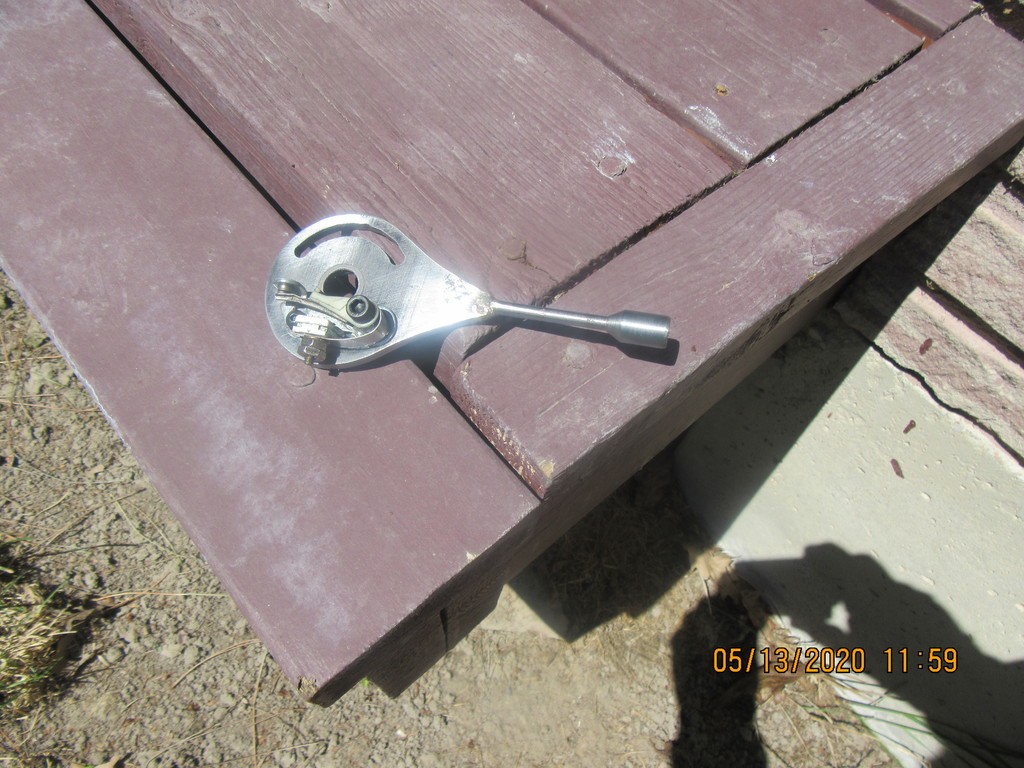

And the ignition timing handle is added. One picture shows the entire engine set up on an angle plate in my milling machine so I could drill and tap the single #10-24 thread thru the side of the engine for the bolt that keeps the timing handle in place. The other picture shows the engine setting on my side table with the installation completed. Tomorrow I will set it up to run and see how big a difference the timing makes to the power output.
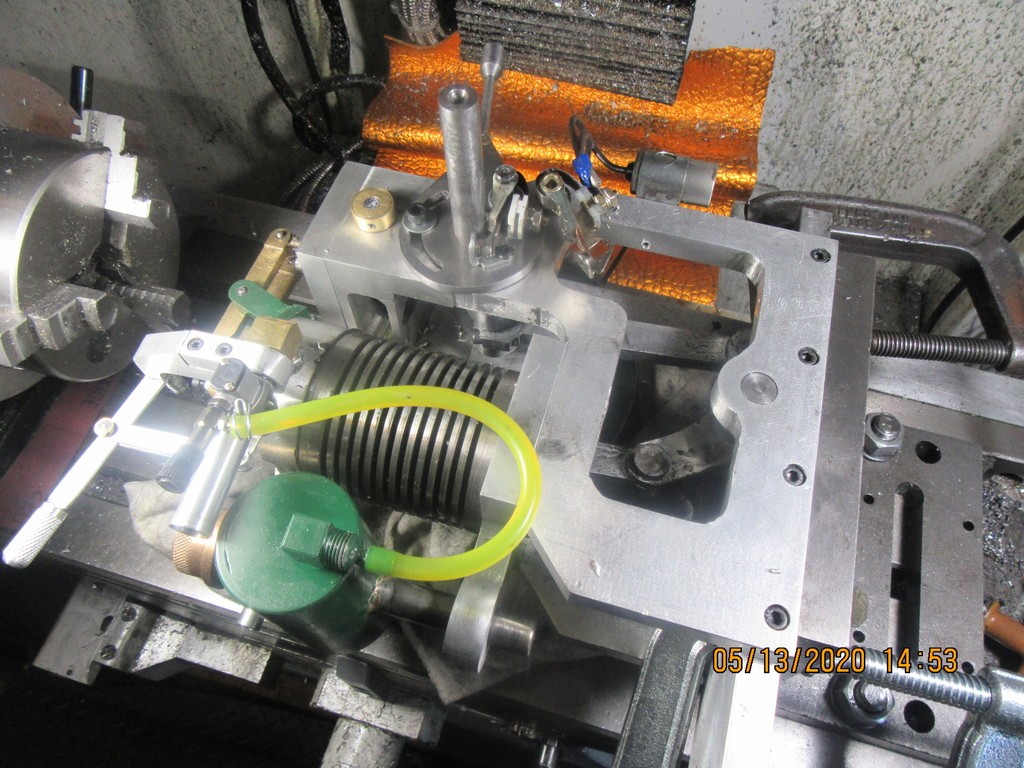
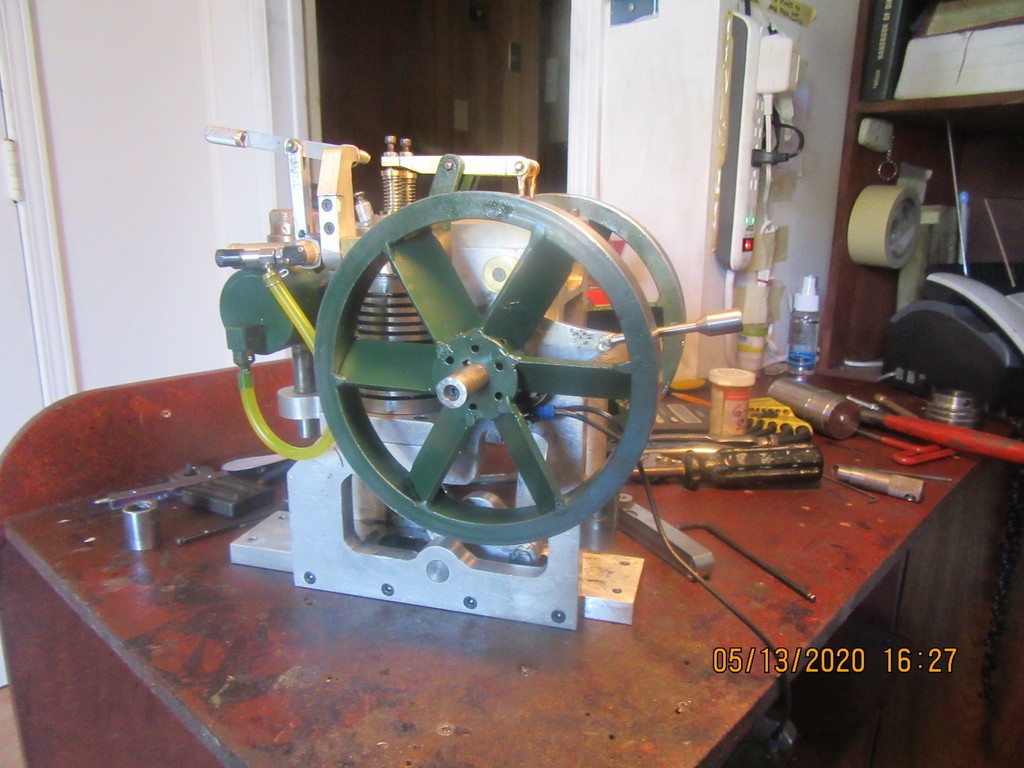


Looks good, keep up the good work.I scrounged around in my flat plate box to find a piece of material to make this manual spark advance from, and the only bit I found close to the right thickness had some rust pits on it. Oh well, that will be hidden in behind the flywheel. I have to call my nut and bolt store and see what they have in the line of Belleveille spring washers so that I can put them under the head of the bolt which goes thru the slot into the engine frame to keep the spark advance from slipping and resetting itself.

Excellent work around Brian. Looking forward to seeing Thumper earn it’s keep!
John W
John W
I just went down to my "Nut and Bolt" store and picked up a dozen Belleville washers. For those of you who haven't heard of them, they are a spring steel flat washer, which have a curve built into them---They're not really flat. In situations like I have with the new timing handle, you want it to stay wherever you set it and not move out of adjustment from engine vibration. However, you do want it to swing freely "by hand" but then remain in place. These Belleville washers are the answer. You can stack 4 of them together and put one ordinary flat washer next to the part which has the slot cut in it. They work very well to put a constant "pre-load" on the part which must be moved by hand but not by engine vibration.
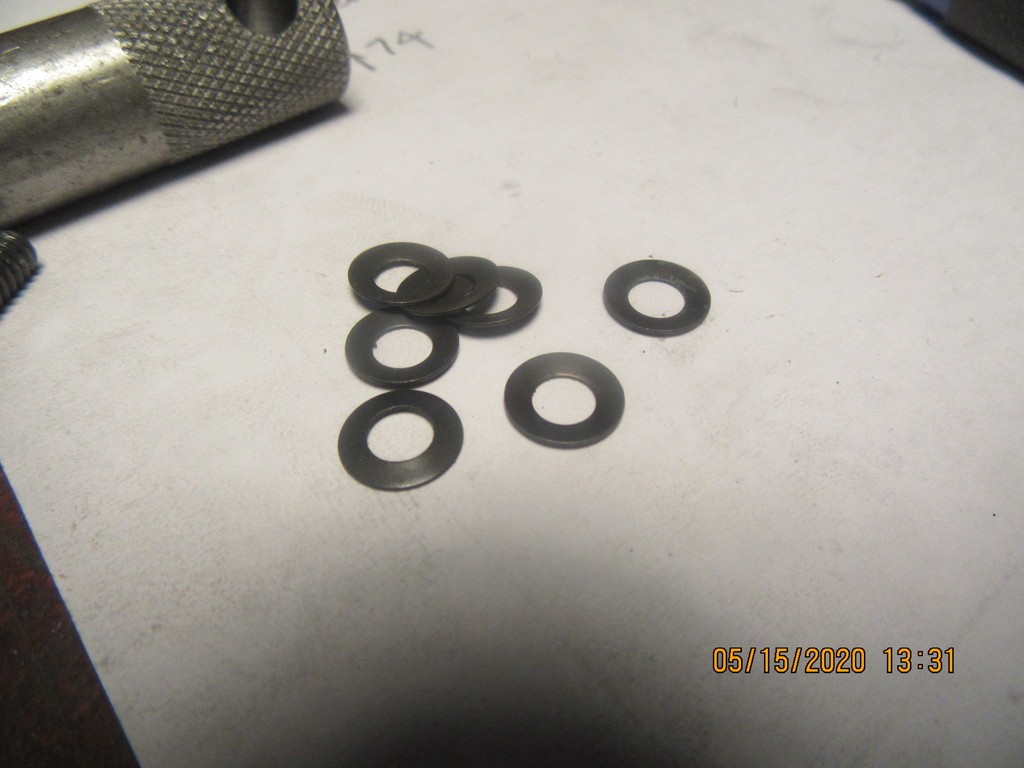

- Joined
- May 20, 2018
- Messages
- 200
- Reaction score
- 86
Brian,I just went down to my "Nut and Bolt" store and picked up a dozen Belleville washers. For those of you who haven't heard of them, they are a spring steel flat washer, which have a curve built into them---They're not really flat. In situations like I have with the new timing handle, you want it to stay wherever you set it and not move out of adjustment from engine vibration. However, you do want it to swing freely "by hand" but then remain in place. These Belleville washers are the answer. You can stack 4 of them together and put one ordinary flat washer next to the part which has the slot cut in it. They work very well to put a constant "pre-load" on the part which must be moved by hand but not by engine vibration.

I bought a set of plans for the "Thumper" engine, and you sent the downloads. I know I got it because I looked at it. When I got back from going to get a memory stick to download it for printing, the plans were gone. I think I inadvertently deleted them. Could you please send them to me again? I sent an e-mail to you, but I think it didn't go through.
Thanks!
Bill
For those who bought a set of plans for this engine----This is the timing handle that I added to the engine.---Brian
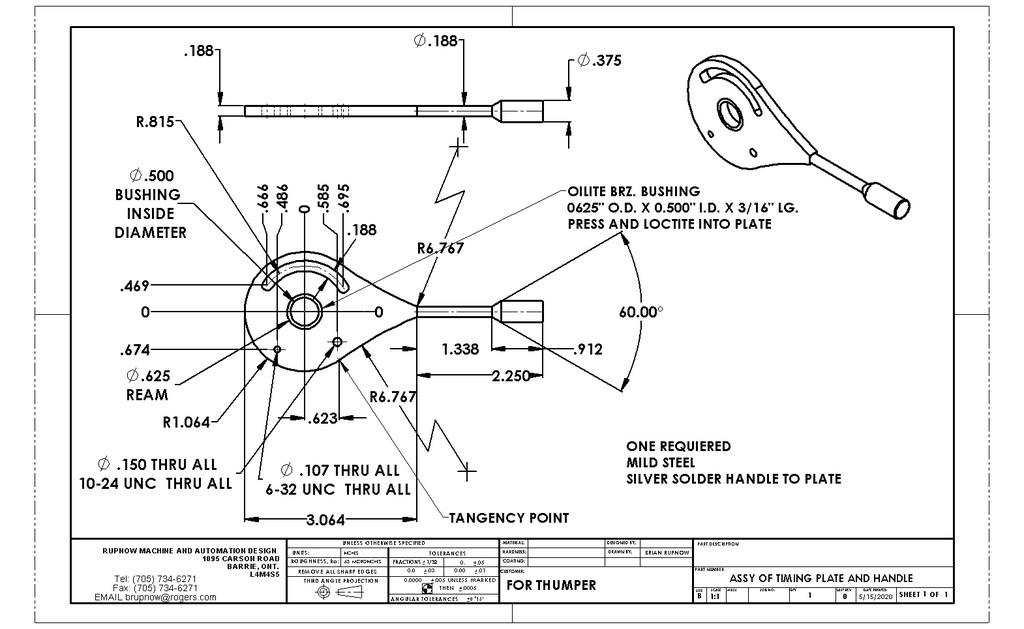

Similar threads
- Replies
- 27
- Views
- 5K
- Replies
- 3
- Views
- 2K










































![MeshMagic 3D Free 3D Modeling Software [Download]](https://m.media-amazon.com/images/I/B1U+p8ewjGS._SL500_.png)









